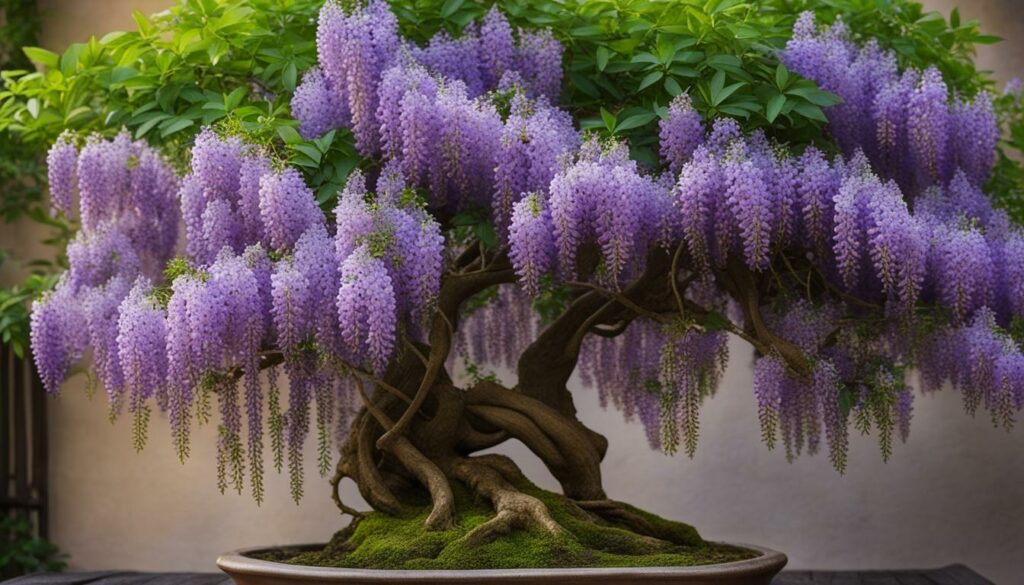If you’re looking for a unique and charming addition to your home garden, consider the Wisteria bonsai. As a flowering vine bonsai, Wisteria adds a touch of elegance and tranquility to any outdoor space. With its striking and fragrant flowers, it’s an excellent choice for any beginner or experienced bonsai enthusiast.
Key takeaways:
- Wisteria bonsai is a charming addition to your garden
- It has striking and fragrant flowers that add elegance to any outdoor space
- It’s an excellent choice for both beginners and experienced bonsai enthusiasts
- Wisteria bonsai is a flowering vine bonsai
- It’s suitable for both indoor and outdoor display
Introduction to Wisteria Bonsai
If you’re looking for a unique and stunning bonsai variety, the Wisteria bonsai is an excellent choice. This vine bonsai species is beloved for its magnificent flowers that bloom in shades of purple, white, and pink. But Wisteria bonsai offers more than just beauty. It’s also known for its resilience and adaptability, making it an excellent option for bonsai enthusiasts of all skill levels.
The origins of Wisteria bonsai can be traced back to Japan, where it has long been treasured for its exquisite flowers. Wisteria species were introduced to Europe and the United States during the 1800s and have since become a popular addition to many gardens because of their unique beauty. The distinctive flowers of Wisteria blooms create a tranquil and peaceful ambiance in any garden.
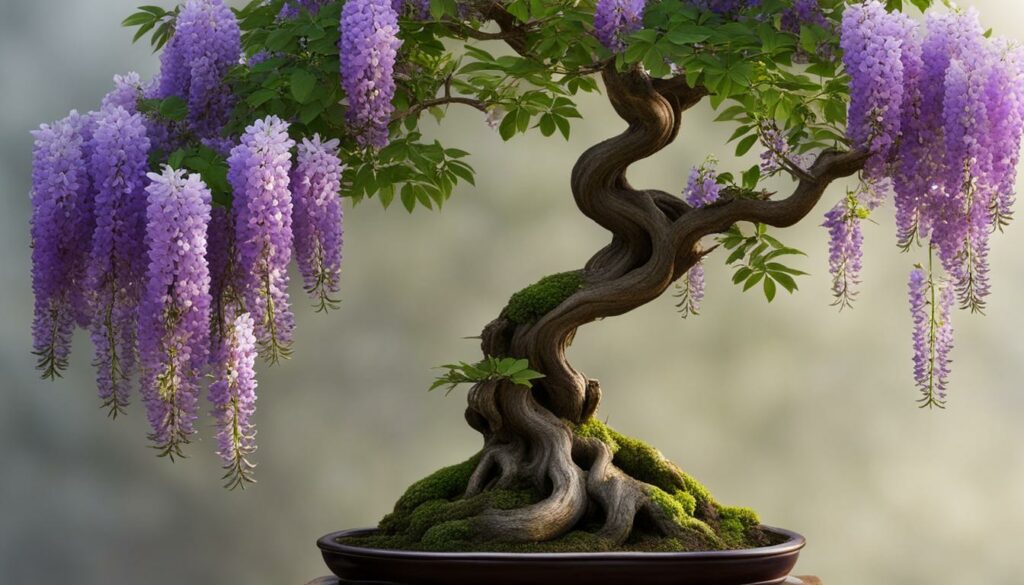
The Wisteria bonsai tree is a unique variety that can grow over 30 feet tall in its natural environment. However, the bonsai version can be drastically reduced in size through careful pruning and shaping techniques. With proper care, Wisteria bonsai can thrive in both indoor and outdoor environments and can be enjoyed as a beautiful addition to any home or garden.
Characteristics of Wisteria Bonsai
Wisteria bonsai is a hardy plant that can tolerate different types of soil and lighting conditions. Its leaves and stems are covered in soft hair, which adds to its aesthetic appeal. The tree is deciduous, meaning that it loses its leaves during the winter months.
“Wisteria bonsai is a popular choice because of its unique beauty, adaptability and resilience. It is an excellent addition to any garden, or indoor setting, and with expert care and attention, it will thrive.”
One of the most notable features of the Wisteria bonsai is its captivating flowers. The pea-like blooms hang in clusters and can grow up to 18 inches long. As mentioned, the color can vary depending on the species and can range from white to dark purple, with pink shades in between. These flowers emit a heavenly scent, making it an excellent choice to keep in your garden.
Pruning Requirements for Wisteria Bonsai
Wisteria bonsai needs regular pruning, as its vines can grow rapidly. Pruning helps maintain the desired shape, improves flowering, and prevents the tree from becoming too large and heavy for its pot. Spring and fall are ideal seasons for pruning your Wisteria Bonsai.
A well-maintained Wisteria bonsai can live for years, becoming even more beautiful with age. With the right balance of care, attention, and pruning, a Wisteria bonsai can create a tranquil garden oasis in any setting.
The Stunning Flowers of Wisteria Bonsai
The Wisteria bonsai’s flowers are truly a spectacle to behold. These flowering bonsai trees produce long and elegant flower clusters that cascade beautifully from their branches. The clusters come in varying shades of purple, pink, white, and blue, adding a pop of color to any garden.
The gorgeous flowers of Wisteria bonsai are not only visually stunning but also have a delightful fragrance that fills the air. The sweet aroma attracts pollinators, adding life to your garden and enhancing the overall experience of cultivating Wisteria bonsai trees.
Wisteria bonsai trees produce flowers in the spring and summer months, offering a prolonged period of blooming. With proper care and maintenance, your Wisteria bonsai will produce a plethora of extravagant flower clusters, becoming the centerpiece of your garden.
When it comes to shaping your Wisteria bonsai, the flowers play an essential role in the overall aesthetic appeal of the tree. As such, pruning techniques must consider the placement of flower buds and the desired flowering pattern.
Choosing the Right Wisteria Species for Bonsai
When it comes to selecting the perfect Wisteria species for your bonsai tree, there are a few factors to consider. Different Wisteria species have unique characteristics that affect their suitability for bonsai cultivation.
Two of the most commonly used Wisteria species for bonsai are Wisteria floribunda and Wisteria sinensis.
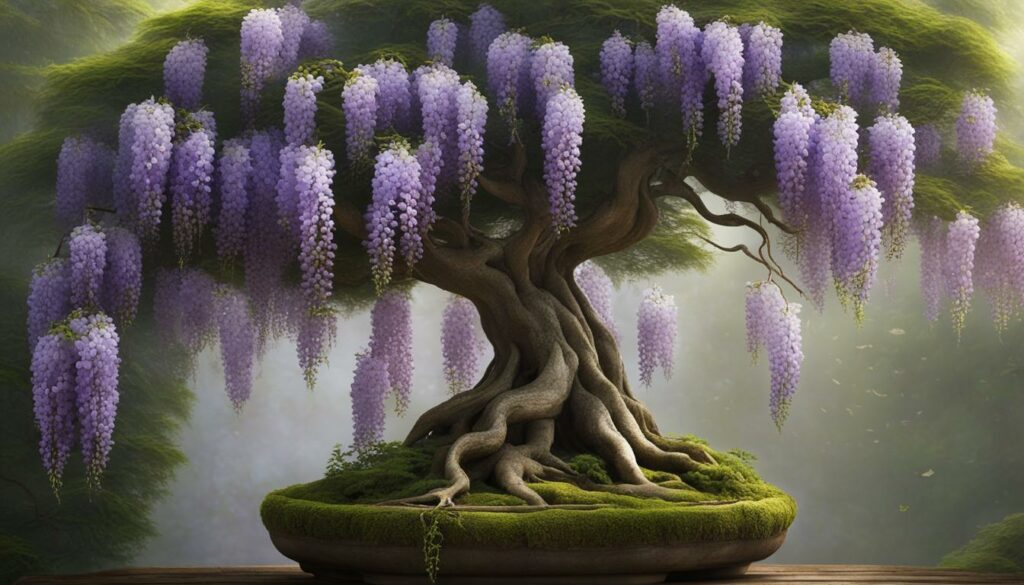
| Species | Description |
|---|---|
| Wisteria floribunda | This deciduous vine is native to Japan and produces stunning, fragrant flowers in shades of blue, purple, and pink. It grows vigorously and can reach up to 30 feet in its natural form, making it a great choice for creating cascading bonsais. |
| Wisteria sinensis | Also known as the Chinese Wisteria, this species is native to China and produces blue, purple, and pink flowers. Its growth rate is slower than the Wisteria floribunda, which makes it ideal for creating bonsais with a more delicate, refined appearance. |
Other Wisteria species that can also be used for bonsai cultivation include the American Wisteria (Wisteria frutescens) and the Silky Wisteria (Wisteria brachybotrys).
Ultimately, the best species for your Wisteria bonsai depends on your preferences and the environment you plan to grow it in. Be sure to select a species that can tolerate the climate and conditions in your area to ensure optimal growth and health for your bonsai tree.
Growing and Caring for Wisteria Bonsai
To cultivate a healthy and thriving Wisteria bonsai, you need to ensure it receives the right amount of sunlight, water and fertilizer. The following guidelines will help you optimize the growth and care of your vine bonsai.
Sunlight Requirements
Wisteria bonsai requires bright, indirect sunlight to thrive. Place your bonsai near a window that receives ample light, but avoid direct sunlight that can cause leaf scorching.
Watering Guidelines
Proper watering is crucial to maintaining a healthy Wisteria bonsai. It is best to water your bonsai once the top inch of the soil feels dry to the touch. Do not overwater, as it can lead to root rot. In addition, make sure water drains freely from the bottom of the container to prevent waterlogging.
Fertilizer Needs
Wisteria bonsai requires regular feeding during the growing season to ensure its optimal growth and development. Use a balanced, water-soluble fertilizer diluted to half its recommended strength every two weeks during the growing season. Reduce feeding frequency during the winter dormant period.
Temperature Considerations
Wisteria bonsai thrives in warm, temperate climates with temperatures ranging from 60 to 75 degrees Fahrenheit. Avoid exposing your bonsai to extreme temperatures or sudden temperature changes, as it can shock the plant and affect its growth and health.
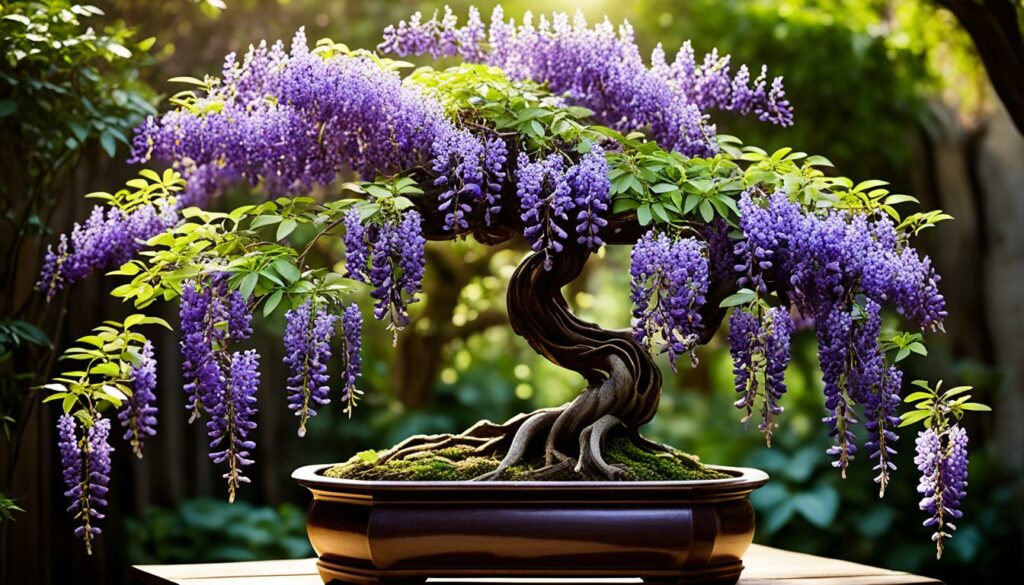
“Proper care and maintenance are key to cultivating a healthy and flourishing Wisteria bonsai.”
Pruning and Shaping Techniques for Wisteria Bonsai
Proper pruning and shaping are essential for maintaining the health and appearance of your Wisteria bonsai. Regular pruning helps to encourage flowering and maintain the compact size of your vine bonsai. Here are some techniques to help you get the most out of your Wisteria bonsai:
Pinching
Pinching is a technique used to encourage branching. Using your fingers or a pair of bonsai shears, remove the tips of new shoots, leaving two or three leaves on each branch. This will cause the plant to redirect energy and produce new buds near the top of the cut branch. Repeat this process throughout the growing season to control the shape of your Wisteria bonsai.
Pruning
Regular pruning is essential for maintaining the shape and size of your Wisteria bonsai. To maintain the compact size of your vine bonsai, prune back long shoots to the desired length. Always prune back to a healthy bud, angling the cut away from the bud. Prune your Wisteria bonsai in the late fall or winter when the plant is dormant.
Cutback
Cutback is a technique used to reduce long branches or remove old wood. To perform cutback, prune off the branch to a point where new growth is present. This technique can be used to redirect energy into new growth, and it can also help to control the size and shape of your Wisteria bonsai.
Wiring
Wiring is a technique used to bend branches and shape your Wisteria bonsai. Carefully wrap wire around the branch you wish to bend, using gentle pressure to shape it into the desired position. Be careful not to wrap the wire too tightly, as this can damage the branch. When the branch has set into its new shape, remove the wire carefully to avoid causing any damage.
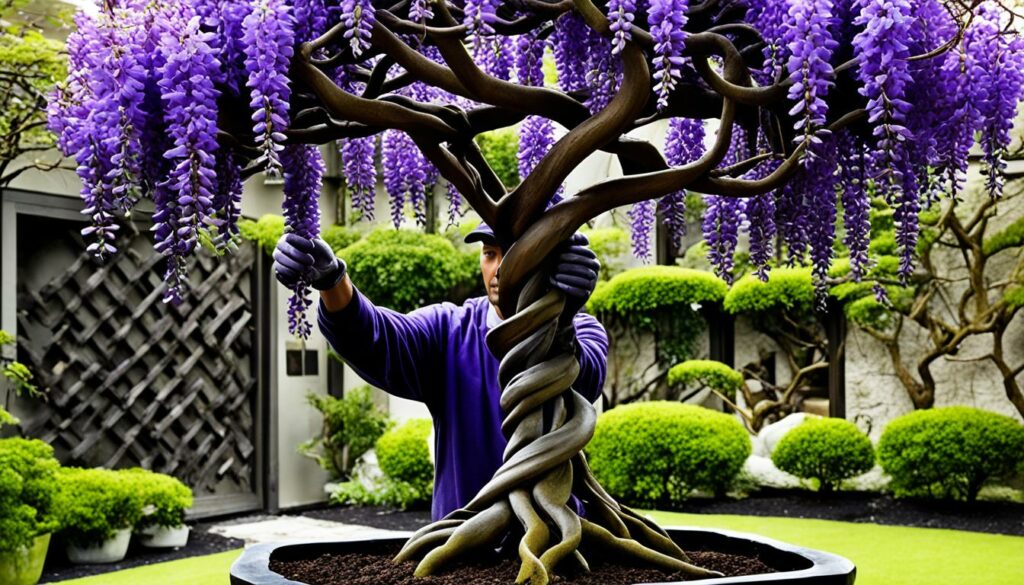
Tip: Always make clean cuts when pruning your Wisteria bonsai to reduce the risk of damage or infection.
By using these pruning and shaping techniques, you can enhance the natural form of your Wisteria bonsai, encourage flowering, and maintain its compact size. With a little care and attention, your vine bonsai will become a truly enchanting addition to your home garden.
Training Wisteria Bonsai to Create Unique Styles
If you want to create a stunning Wisteria bonsai, training and wiring it to achieve unique styles is essential. Luckily, Wisteria bonsai is a versatile plant that lends itself to various bonsai styles.
One popular style for Wisteria bonsai is the cascade style. This style involves training the trunk to grow down the side of the container, creating a waterfall effect. To achieve this style, you will need to wire the trunk and branches to control their growth.
Another striking bonsai style for Wisteria is the windswept style. This style mimics the effects of strong winds on the tree, with the branches and leaves growing in one direction. To create this look, place the tree in a location with strong winds or use wire to control the direction of growth.
The informal upright style is also a great option for Wisteria bonsai. In this style, the main trunk is straight, while the branches grow out at different angles. This style works well for Wisteria bonsai because of its natural branching habits.
Training and Wiring Techniques for Wisteria Bonsai
When training Wisteria bonsai, it’s important to use pliable wire and avoid wrapping it too tightly around the branches or trunk. Start by securing the wire to the container and then wrap it around the branch, gradually curving it in the desired direction. Avoid bending the branch too much or too quickly, as this can damage the bark.
Use pruning shears to trim back any unwanted growth and create a more compact shape. Be sure to take your time and make small adjustments to the wire as needed to avoid damaging the tree.
With patience and careful training, you can create an exquisite Wisteria bonsai that showcases your unique style and creative vision.
| Style | Description |
|---|---|
| Cascade | Trunk grows down the container, creating a waterfall effect |
| Windswept | Branches and leaves grow in one direction, mimicking the effects of strong winds |
| Informal upright | Main trunk is straight while the branches grow out at different angles |
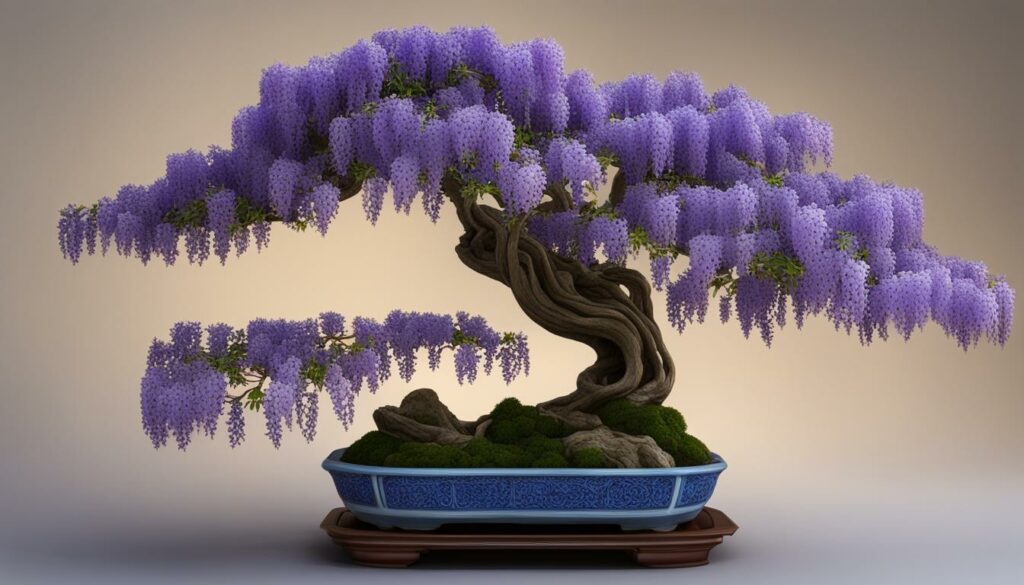
Repotting Wisteria Bonsai for Optimal Growth
As your Wisteria bonsai grows, it will eventually outgrow its current pot, requiring repotting to ensure optimal growth. Repotting also promotes root health and prevents overcrowding, which can lead to a lack of nutrients and water. Ideally, Wisteria bonsai should be repotted every 2-3 years in the spring, just prior to the start of the growing season.
When repotting your Wisteria bonsai, choose a pot that is slightly larger than its current pot, allowing enough space for roots to grow. Fill the new pot with well-draining soil, such as a mixture of akadama, pumice, and lava rock. Before removing your bonsai from its current pot, water it thoroughly to prevent damage to the roots during the repotting process.
Pro tip: Use a bonsai root rake to gently remove the old soil from the roots, making it easier to ensure proper placement of your Wisteria bonsai in its new pot.
After removing the old soil, inspect the roots for any signs of damage or disease. Trim any damaged roots with clean, sterile pruning shears and apply a rooting hormone to promote healthy new growth.
Once you have trimmed the roots, position your Wisteria bonsai in the new pot, adding soil around the roots to hold it in place. Water thoroughly to eliminate air pockets and promote root growth. Add a top layer of moss or decorative rocks to help retain moisture and provide a finished look.
Tip: Avoid fertilizing your Wisteria bonsai for several weeks after repotting to allow it to recover and adjust to its new soil and pot.
Common Pests and Diseases of Wisteria Bonsai
Wisteria bonsai can fall prey to various pests and diseases, which can impact their health and development. Here are common pests and diseases you should be aware of:
| Pest/Disease | Symptoms | Prevention/Treatment |
|---|---|---|
| Aphids | Yellowed, curled, or distorted leaves, sticky residue on leaves | Use insecticidal soap or neem oil, or introduce ladybugs or lacewings to eat the aphids. Spray with water to remove them. |
| Scales | Small, raised bumps on leaves, stems, and branches, yellowing leaves, sticky residue on leaves | Remove scales with a cotton swab soaked in alcohol or insecticidal soap. Apply horticultural oil spray or neem oil to control infestations. |
| Fungal diseases | Discolored or spotted leaves, wilting or drooping foliage, fungal growths on trunk or branches | Ensure proper drainage and good air circulation. Remove infected leaves or branches. Apply fungicide as directed. |
| Root rot | Yellowing leaves, wilting or drooping foliage, stunted growth, brown or black roots | Ensure proper drainage and avoid overwatering. Remove affected roots. Repot with fresh, well-draining soil mix. |
To keep your Wisteria bonsai healthy and thriving, make sure to inspect them regularly for signs of pests or diseases. Early detection and treatment are essential for preventing a small problem from turning into a larger issue.
Displaying Wisteria Bonsai in Your Garden or Home
Now that you have successfully cultivated your Wisteria bonsai, it’s time to showcase its exceptional beauty by displaying it in your garden or home. The right container, display location, and complementary plants or accessories can enhance the overall aesthetic appeal of your bonsai.
Firstly, choose a container that matches the size and style of your bonsai. Ceramic pots are a popular choice as they provide good drainage, stability, and durability. You can opt for plain or ornate designs, depending on your taste.
Next, consider the display location. Wisteria bonsai, being a vine bonsai, can be trained to cascade over a rock or container, creating a unique and striking display. You can also place it on your porch or balcony, where it can receive partial shade to protect it from scorching sunlight.
To enhance the overall look, you can complement your Wisteria bonsai with suitable plants or accessories. Consider adding ivy or moss on top of the soil to create a natural look, or add a small bonsai figurine to your display for a touch of whimsy.
| Container | Display location | Complementary plants or accessories |
|---|---|---|
| Ceramic pot | Balcony | Ivy |
| Ornate container | Rock display | Moss |
| Terracotta pot | Porch | Bonsai figurine |
Showcasing your Wisteria bonsai is an opportunity to share its exquisite beauty with others while adding a serene and elegant touch to your environment.
Conclusion
Cultivating a Wisteria bonsai is a rewarding experience for any gardener who appreciates the beauty of flowering vine bonsai. As we have seen, the Wisteria bonsai offers exquisite flowers, adaptability, and ease of care, making it an excellent choice for both novice and experienced bonsai enthusiasts.
By following the essential steps to grow and care for your Wisteria bonsai, including choosing the right species, providing proper sunlight, water, and fertilizer, and pruning and shaping techniques, you can create a stunning and unique addition to your home garden or indoor space.
Remember to repot your bonsai periodically and watch out for potential pests and diseases, such as spider mites, aphids, and fungal infections, to ensure the long-term health and vitality of your Wisteria bonsai.
Showcase your bonsai in a suitable container and display location, complemented by other plants or accessories that accentuate its beauty and charm. Your Wisteria bonsai is sure to be the envy of any nature lover.
So go ahead, choose the Bonsai Tree Species Wisteria, and embark on a journey of discovery and awe-inspiring beauty that only a flowering vine bonsai can offer!
FAQ
What is a Wisteria bonsai?
A Wisteria bonsai is a miniature version of the Wisteria vine that has been trained and shaped into a bonsai form. It is known for its delicate, cascading flowers and compact size.
How do I care for a Wisteria bonsai?
To care for a Wisteria bonsai, you will need to provide it with ample sunlight, water it regularly but avoid overwatering, fertilize it during the growing season, and protect it from extreme temperatures. Proper pruning and shaping techniques are also important for maintaining its health and appearance.
Can I grow Wisteria bonsai indoors?
While Wisteria bonsai can be grown indoors, they thrive best in outdoor environments where they can receive sufficient sunlight and air circulation. If grown indoors, it is essential to place the bonsai near a south or west-facing window to ensure it gets enough light.
When does Wisteria bonsai flower?
Wisteria bonsai typically blooms during the spring season, usually in April or May, depending on the climate. The flowers can range in color from white to lavender to deep purple and create a breathtaking display.
How often should I repot my Wisteria bonsai?
Wisteria bonsai should be repotted every 2 to 3 years, ideally in early spring before new growth begins. Repotting helps refresh the soil, prevent root rot, and promote healthy growth.
What are the common pests and diseases that affect Wisteria bonsai?
Some common pests that can affect Wisteria bonsai include aphids, scale insects, and spider mites. Diseases such as powdery mildew and root rot can also be a concern. Regular inspections and proper care can help prevent and treat these issues.
Can I shape my Wisteria bonsai into different styles?
Yes, Wisteria bonsai can be shaped into various bonsai styles, including cascade, windswept, and informal upright. Training techniques, such as wiring and pruning, can help achieve these styles and create unique and visually striking designs.
How long does it take for a Wisteria bonsai to bloom?
The time it takes for a Wisteria bonsai to bloom can vary depending on factors such as the age of the bonsai, the health of the plant, and the care it receives. Generally, Wisteria bonsai can take 5 to 7 years or longer before they start flowering.
Can I plant my Wisteria bonsai in the ground?
While it is possible to plant Wisteria bonsai in the ground, it is often recommended to keep them in containers for easier maintenance and control. Planting in the ground may result in the roots becoming too large and possibly damaging structures or becoming invasive.
How do I overwinter my Wisteria bonsai?
During winter, it is essential to protect your Wisteria bonsai from freezing temperatures. You can place it in a garage, shed, or other sheltered area where temperatures remain above freezing. Insulating the pot with mulch or wrapping the entire bonsai with burlap can provide additional protection.
